
Diary: The garden in March 2000

 | Diary: The garden in March 2000 |

|
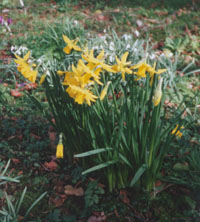 The 1st of March is St. David's Day, the Patron Saint of Wales. It is traditional to wear a daffodil, or a leek, on this day. There is usually no problem finding a leek, but daffodils can be scarce at this time of year. For the last 2-3 years there has been no difficulty in finding locally grown daffodils as well. The mild winters have meant that there are plenty in the gardens.
The 1st of March is St. David's Day, the Patron Saint of Wales. It is traditional to wear a daffodil, or a leek, on this day. There is usually no problem finding a leek, but daffodils can be scarce at this time of year. For the last 2-3 years there has been no difficulty in finding locally grown daffodils as well. The mild winters have meant that there are plenty in the gardens.
The wet weather continued at the beginning of the month so that any work planned for the garden was delayed. On the 3rd early bluebell leaves in the wood had grown to 7-8 cm tall, but new ones were appearing every day. There are plenty of primroses in flower all over the garden their yellow colour contrasting with the blue squill Chionodoxas Glory of the Snow. Despite the 3/4th being the coldest night of the year, with much hoarfrost on the ground in the morning, it was sunny and felt quite warm in the garden, as there was little or no wind. A few honeybees were seen on the heathers for the first time this year.
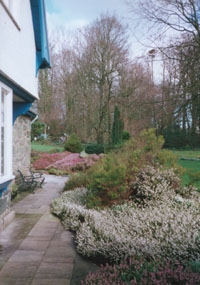
A local beekeeper has several hives across the field from the garden and the heathers are often covered with bees on warm days at this time of year. They seem to appear on the heathers when the temperature is near 10C. In previous days we have seen several large and a few smaller bumblebees around the garden these have emerged from their overwintering hideaway. They can tolerate much lower temperatures than honeybees and from now onwards will be seen out in all weathers.
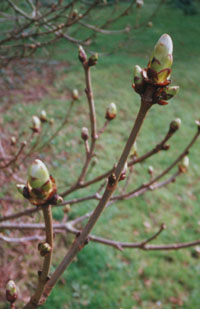
A goldcrest was also seen searching for insects in a conifer tree and later a long-tailed tit was spotted. We have not seen a goldcrest since November and a long-tailed tit since April of last year. Both put in an appearance at this time of year and will nest nearby. Sometimes we see small flocks of long-tailed tits passing through the garden or wood but they never stay very long. We have so far been unable to attract either goldcrest or long-tailed tits to our feeders. During the afternoon a buzzard flying too near the rookery was noisily driven off by some of the rooks. In the greenhouse the chrysanthemum stools have produced a lot of new shoots and it will soon be time to commence taking the cuttings. This job was put off, as with the better day some work was possible outside. although the ground is still very wet some tidying up was done in preparation for more serious work in a week or two. On the 6th rooks were seen breaking off twigs from the trees around the garden to renovate their nests. They only seem to break off living twigs from the treetops although there are plenty of similar ones lying on the ground following recent gales. It is probable that the rooks select new twigs because they would be stronger than those lying on the ground. Sometimes, although they have strong beaks, it is quite a struggle for them to break the twig. In the hedge bounding the road past the house the hawthorn (Crategus monogyna) has begun to green-up. Elsewhere the white flowers of the blackthorn or sloe (Prunus spinosa) have appeared. The leaves of hawthorn are produced before flowers whereas with blackthorn the flowers appear first. This gives the hedges the very odd appearance of white and green patches at this time of year. There was a dispute between 2 mistle thrushes on the lawn on the 10th. Territories from time to time are still in dispute. The leaves of snowberry (Symphoricarpos albus var. laevigatus) and elderberry (Sambucus nigra) in the wood are beginning to open and the sticky buds on the horse chestnuts are fit to burst. The smallest of green leaf is also appearing on raspberries. On the rockery there are now several flowers open of the purple saxifrage Saxifraga oppositifolia and in the damp area flowers of Primula denticulata.
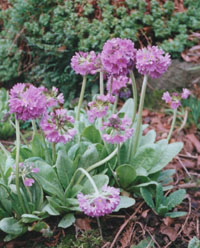
By the afternoon of the 11th it had become sunny and the temperature had risen to 11.5C. Lots of honeybees were seen gathering pollen on the heathers, clearly advantage was being taken of the warmer day. The scout bees, seen on the 4th, must have passed on the message that the heathers were the place to be. 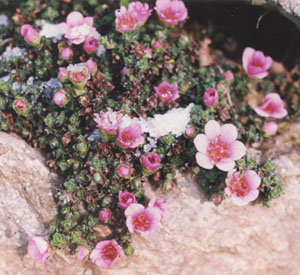 The grass on the lawns was sufficiently dry to allow a start to the grass-mowing season to be made. An early cut is always worth doing when conditions allow, trimming back the growth made overwinter. Much growth has been made, since the last cut, as grass grows all year here more so because the winter has been so mild. A mistle thrush has been gathering dead strands of the rockery plant Phuopsis stylosa for nesting material. We leave the remains of this plant on the rockery because we know from previous years that the mistle thrushes come to gather it. This usually takes place in the morning and there is much toing and froing from rockery to wood. The bird uses a circuitous route so as not to easily reveal its nesting place. Predators are always around and today we saw 3 jays at the top of a tall tree in the wood. At 10.30 pm we heard two tawny owls hooting and screeching to each other in the trees. They were probably male and female birds but we could not see them, as it was a very dark night. In the greenhouse on the 12th chrysanthemum cuttings were taken for rooting in small clay pots. I use a 50:50 mixture of peaty compost and vermiculite and the small cuttings (about 5 cm cut just below a node, lower leaves removed leaving 3-4) are placed around the edge 4 to a 3in pot. After watering the pots are put in the propagating frame with bottom heat. There was a good supply shoots of most varieties we grow except Snowshine and Olga Paterson. These will be looked for again a bit later on when hopefully some more shoots have formed.
The grass on the lawns was sufficiently dry to allow a start to the grass-mowing season to be made. An early cut is always worth doing when conditions allow, trimming back the growth made overwinter. Much growth has been made, since the last cut, as grass grows all year here more so because the winter has been so mild. A mistle thrush has been gathering dead strands of the rockery plant Phuopsis stylosa for nesting material. We leave the remains of this plant on the rockery because we know from previous years that the mistle thrushes come to gather it. This usually takes place in the morning and there is much toing and froing from rockery to wood. The bird uses a circuitous route so as not to easily reveal its nesting place. Predators are always around and today we saw 3 jays at the top of a tall tree in the wood. At 10.30 pm we heard two tawny owls hooting and screeching to each other in the trees. They were probably male and female birds but we could not see them, as it was a very dark night. In the greenhouse on the 12th chrysanthemum cuttings were taken for rooting in small clay pots. I use a 50:50 mixture of peaty compost and vermiculite and the small cuttings (about 5 cm cut just below a node, lower leaves removed leaving 3-4) are placed around the edge 4 to a 3in pot. After watering the pots are put in the propagating frame with bottom heat. There was a good supply shoots of most varieties we grow except Snowshine and Olga Paterson. These will be looked for again a bit later on when hopefully some more shoots have formed.
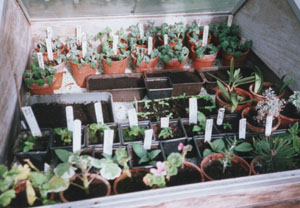
Seed of tomato were sown a little later than usual. My normal sowing date is the middle of February so the plants will be a little late this year. I always include Gardeners Delight, from saved seed, because they crop well and the taste is always good. The snowdrops have all finished in the garden and their leaves are growing rapidly so that they begin to look untidy. The daffodils should now be at their best but the bulbs this year have not produced as many flowers as usual, although there are plenty of green leaves. This sometimes happens, there are enough to draw the eye away from the snowdrops and the last of the crocuses but are not a good display. The newly planted patch Millennium Star is very good and make up for the lack of the older bulbs. The first Camellia flowers are open; ours is a later flowering variety than some which have been in flower in the area for a few weeks. A later flowering type is useful to have if there are frosts but not this year as there have been very few so far. Our plant is unusual because half the plant has pink flowers and the other a mixed pink and white flower. The plant is low growing and the flowers tend to be rather shy under the leaves, good for frost protection but not for display. Along the lanes near the house on the 17th several new flowers of campion were seen together with more lesser celandine and dandelion. The wall pennywort (Umbilicus rupestris) was growing in profusion on the walls and there were good plants of foxglove (Digitalis purpurea) at least 30 cm tall. Birdsong around the garden and wood is very strong. Patricia spotted the return of a male siskin seen on a peanut feeder. Rather later in the year than we have seen them previously. The mistle thrushes tend to dominate the morning and evening chorus starting very early when hardly light and finishing just after dark. On the evening of the 19th 3 mistle thrushes were spotted in the topmost branches of a very tall sycamore tree. They were perched equidistant in a triangle, one was singing and the other two appeared to be listening! It is unusual to see 2 let alone 3 together like this. The mistle thrushes have in recent days been joined in the garden by a singing song thrush and a blackbird. Both of these are very mellow singers and we are particularly glad to have a good singing blackbird again. There was a very good singer a few years ago, which used to take up position on the electricity pole near the house. After several years he must have died and until now his replacements were not the best singers. This year he is a very good singer and usually gives a good performance from about 4 pm onwards. There are several singing blackbirds in the vicinity and for some reason all appear better singers this year.
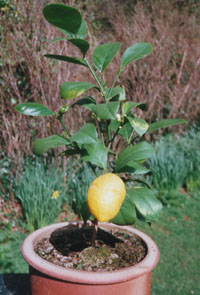
The siskins, male and now female, are regular visitors once again. They usually feed together on the peanuts. The male is quite an aggressive little bird and will not tolerate others feeding at the same time even driving off the larger greenfinch. Of course there may be more than a pair but we have only seen the 2 birds at any one time. We sowed nine varieties of sweet peas in pots in the greenhouse on the 20th. The sweet pea is a favourite flower of us both and we cannot imagine not growing them in the garden. Timing of sowing and planting is very important, as the season is so short here. Too early and when planted out they can be set back if the weather turns cold and are subject to bud drop following cold nights, and too late and an early autumn spoils them just as they are at their best. While in the greenhouse it was seen that the buds of the grapevine have began to open. Of course there is no sign of the buds opening on the vines in the garden. Also in the greenhouse at the moment is a small lemon tree. It is a hardy variety Meyeri that can withstand a little frost. We keep it in the greenhouse in the winter and move it into a warm place in the garden for the summer. It produces, although still small, plenty of highly scented flowers in the spring and surprisingly has produced a ripe lemon this year. It took a year to grow and ripen and was picked today; it was excellent in a gin and tonic! The 22nd was a good sunny day and while working in the garden the first chiff-chaff of the summer was heard singing in a willow tree. The buds on the horse chestnut are bursting open and looking like pale green candles on the tree. Several more chiff-chaffs had arrived on the 25th and were busy singing in different parts of the garden and wood. It was another sunny day and the ground had dried sufficiently to allow some returfing to be done around a redeveloped part of the garden. In front of the greenhouse the area was one of our vegetable plots but has now been turned into a flower border. The returfing was to change the shape from a rectangular vegetable plot into a more pleasing triangular shape. The shape also has to take account of the raingauge, which cannot be moved, as it is in the best place in the garden to record rainfall chosen by the Meteorological Office. The aim is to grow roses and as many types of lavender as we can find. Roses are a challenge here and we have chosen some of the newly developed old rose types, regosa types and the climber Zephirene Drouhin both of that grow reasonably well here. Patricia also has cuttings of an old red climbing rose that was grown by her Grandfather. This will be grown on a new fence I am erecting along a path to the greenhouse that borders the new garden.
On the 26th in the afternoon we walked the short distance to the garden of our friends Mari and Gwilym. They have been gardening here at Gadlys almost as long as we have and we often compare notes. Their garden has like ours been developed from an old established garden. Mari has added her own style and edged all the flower borders with dwarf box. This has taken many hundreds of plants over the years and is nearly completed. They also have a small vegetable garden, which has already been dug over in contrast to ours. The woodland is more open than ours is and the ravages of Dutch elm disease and recent gales have increased this openness. New trees have been planted but these will take some years to attain any great size. The former owner planted many hundreds of daffodil bulbs and, in contrast to ours this year, was a wonderful display. 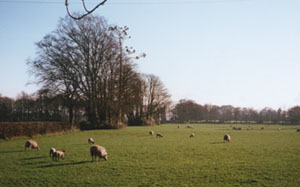 Our main mission was to inspect a new primula bed, which had been recently planted. At Mari's request we had grown for her from seed in our greenhouse plants of the primula Cowichan Amethyst and Garnet. There is much controversy about the origin of the Cowichan primrose but a version is that in the 1930's someone in the Cowichan Valley in Canada found a deep purple-red primrose without an eye and with red tinged leaves in a batch of seedlings. The plants are unusual and it is the first time we have seen them in flower. Mari had planted them in a bed with other primroses and primulas and it will be interesting to see how they develop. In our garden we have grown primroses and various primulas for many years. There is no difficulty growing them here, they pop up everywhere. They have hybridised, and from the normal primrose and a deep red primula, we now have many different types. Every spring it is interesting to see what shades of hybrid have sprung up. We also have cowslips, which grow very well, under our conditions. We have them springing up everywhere even in the vegetable plot. These are very useful as seedling plants to give to friends, Mari has had several, and to re-establish in different places in the garden. We are also lucky to have several plants of the rather rare oxlip hybrid, the cross between the primrose and cowslip. Normally this is yellow flowered but occasionally a coloured one appears. The primroses and primulas are at their best at the moment but the cowslips are later. I have seen one or two oxlips in flower these seeming to be also earlier than the cowslip. The fields surrounding the house have, since January, enclosed increasing numbers of sheep and their lambs. The lambing is done in sheds and when born the ewe and usually 2 lambs are put in the fields. The numbers of sheep have, over recent years, increased on Anglesey farms all the year round. In years past they were only seen in large numbers in the winter, being sheep brought down from the mountains and returned in the summer.
Our main mission was to inspect a new primula bed, which had been recently planted. At Mari's request we had grown for her from seed in our greenhouse plants of the primula Cowichan Amethyst and Garnet. There is much controversy about the origin of the Cowichan primrose but a version is that in the 1930's someone in the Cowichan Valley in Canada found a deep purple-red primrose without an eye and with red tinged leaves in a batch of seedlings. The plants are unusual and it is the first time we have seen them in flower. Mari had planted them in a bed with other primroses and primulas and it will be interesting to see how they develop. In our garden we have grown primroses and various primulas for many years. There is no difficulty growing them here, they pop up everywhere. They have hybridised, and from the normal primrose and a deep red primula, we now have many different types. Every spring it is interesting to see what shades of hybrid have sprung up. We also have cowslips, which grow very well, under our conditions. We have them springing up everywhere even in the vegetable plot. These are very useful as seedling plants to give to friends, Mari has had several, and to re-establish in different places in the garden. We are also lucky to have several plants of the rather rare oxlip hybrid, the cross between the primrose and cowslip. Normally this is yellow flowered but occasionally a coloured one appears. The primroses and primulas are at their best at the moment but the cowslips are later. I have seen one or two oxlips in flower these seeming to be also earlier than the cowslip. The fields surrounding the house have, since January, enclosed increasing numbers of sheep and their lambs. The lambing is done in sheds and when born the ewe and usually 2 lambs are put in the fields. The numbers of sheep have, over recent years, increased on Anglesey farms all the year round. In years past they were only seen in large numbers in the winter, being sheep brought down from the mountains and returned in the summer.
A goldfinch was seen on the 28th feeding on peanuts. In the greenhouse the chrysanthemum cuttings are doing well, on sunny days it is necessary to spray them with water so that they do not become dried out. Soon they will have developed roots and this will be unnecessary. Four types of lettuce seed were sown today. We grow green and red Salad Bowl, Little Gem and Frillice. The later is a new frilly variety of the salad bowl type, which we tried for the first time last year. It proved very successful and we have added it to our seed list.
Document dated: 23 May 2000. This page is part of the site maintained at http://www.llansadwrn-wx.co.uk
Copyright ©: 2000 Donald and Patricia Perkins